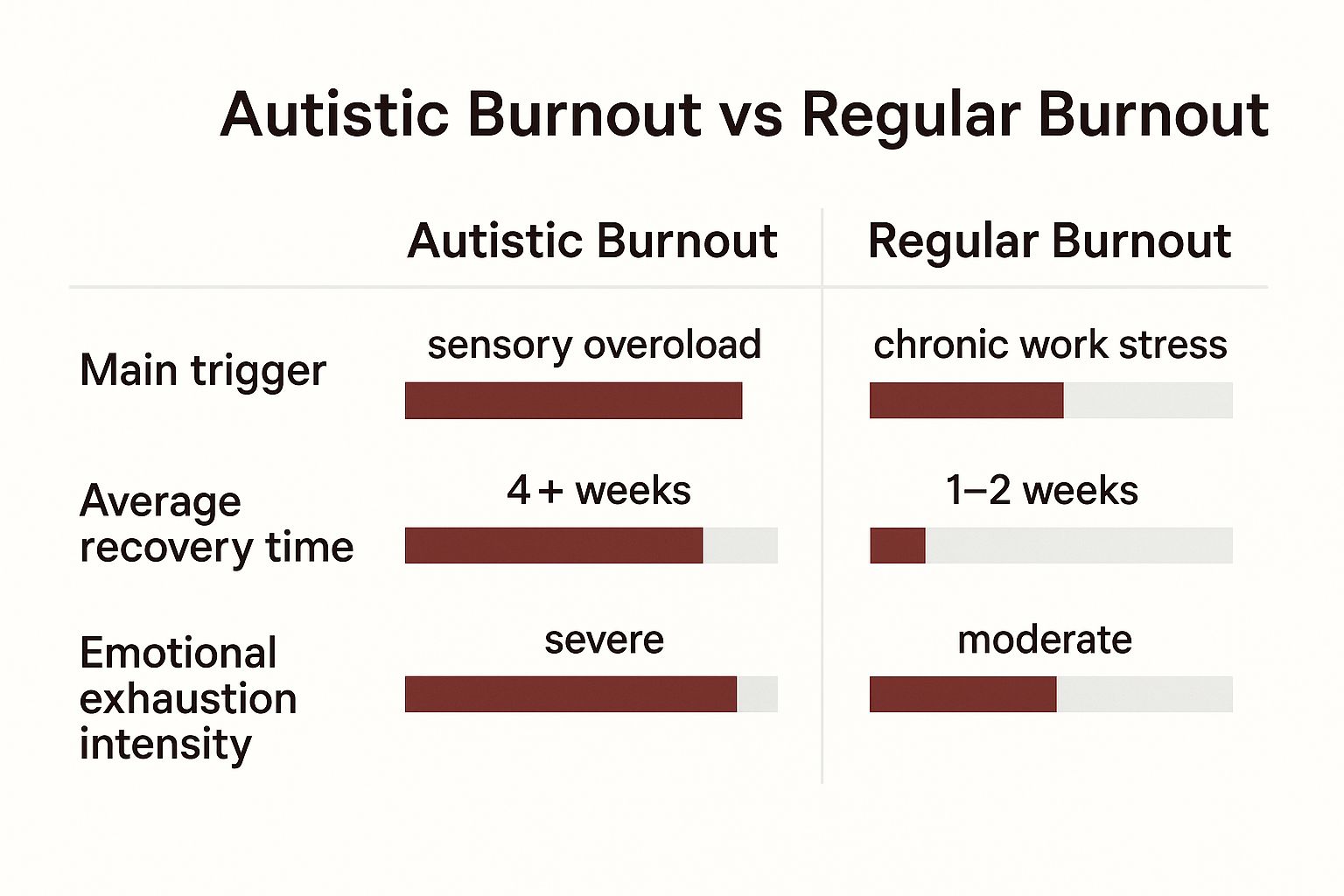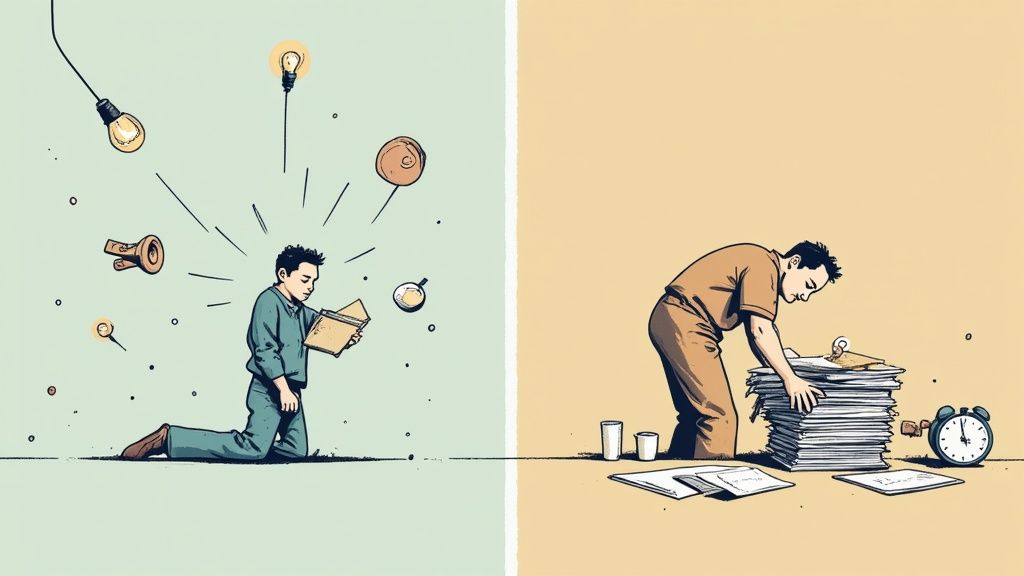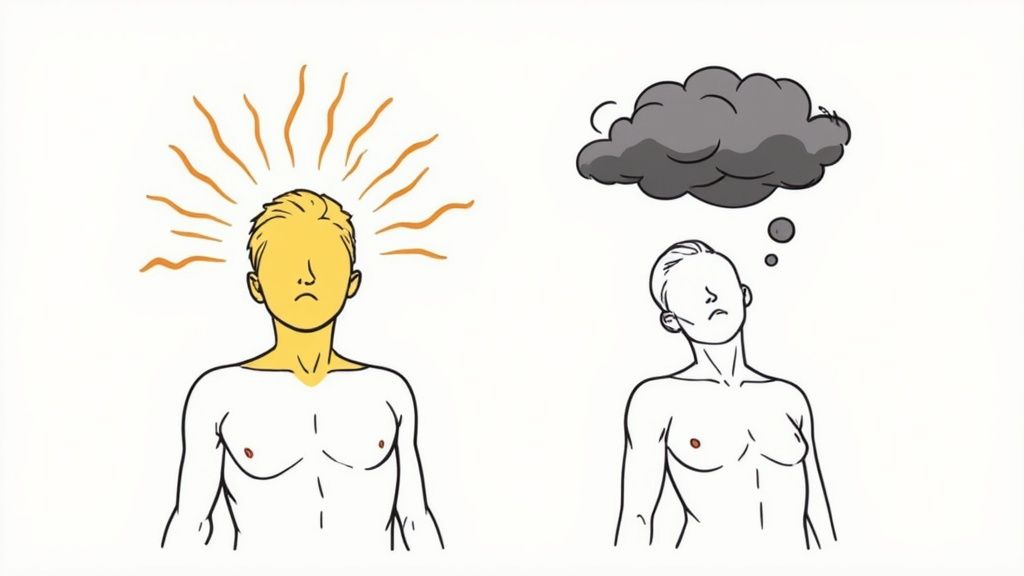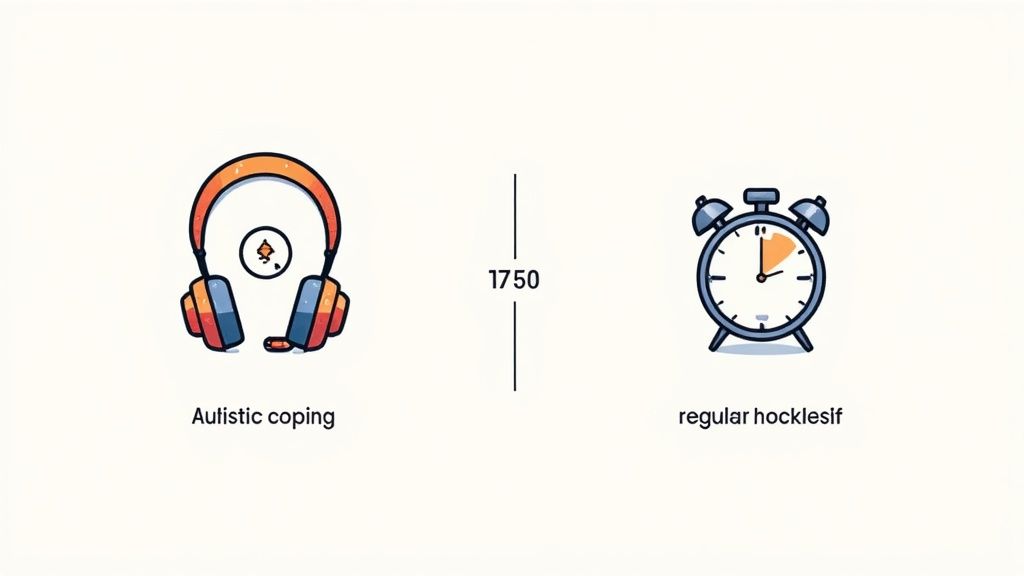At their core, autistic burnout vs regular burnout feel worlds apart, even if both leave you utterly exhausted. The fundamental difference really comes down to their origins and how they impact you. Think of regular burnout as being tied to chronic stress, usually from work. Autistic burnout, on the other hand, is born from the constant, cumulative weight of trying to exist in a world that wasn't built for neurodivergent minds. This often leads to a far more profound breakdown, including a loss of skills and overwhelming sensory distress.
Understanding The Core Differences In Burnout
Burnout, in any form, is a state of deep physical, emotional, and mental exhaustion. But where that exhaustion comes from is the key to understanding the distinct experiences of autistic burnout versus regular, or occupational, burnout. They are absolutely not the same thing, and trying to fix one with the solutions for the other just won't work.
When you look closer, their causes, symptoms, and recovery paths are dramatically different. Autistic burnout is often the result of sensory overload, the intense pressure of social demands, and the sheer cognitive load of "masking"—the exhausting act of hiding autistic traits to fit in. Regular burnout, however, almost always traces back to chronic professional stress.
The symptoms diverge, too. With autistic burnout, the chronic exhaustion is coupled with a frightening loss of skills—things you could once do easily now feel impossible—and a sharp increase in sensory sensitivities. Regular burnout shows up as fatigue, irritability, and cynicism, but without that same loss of fundamental abilities. You can read a deeper analysis of the connections between autistic burnout and an autistic shutdown which often go hand-in-hand.
This visual breakdown highlights the key differences in triggers, recovery time, and the emotional toll of each type of burnout.
It’s clear that autistic burnout is a much more severe and long-lasting experience, rooted in systemic and sensory challenges that go far beyond just workplace stress. Getting this distinction right is absolutely vital for finding the right kind of support and starting to heal.
Quick Comparison Autistic Burnout vs Regular Burnout
To make the differences even clearer, the table below offers a quick, at-a-glance summary of the key characteristics that set one apart from the other. This can be a helpful starting point to identify which experience aligns more closely with what you or someone you care about is going through.
| Characteristic | Autistic Burnout | Regular Burnout |
|---|---|---|
| Primary Cause | Cumulative social and sensory overload; masking | Chronic, unresolved workplace stress |
| Key Symptoms | Loss of skills, extreme fatigue, sensory issues | Cynicism, exhaustion, reduced effectiveness |
| Recovery Focus | Deep rest, reducing demands, unmasking | Time off work, stress management, changing roles |
| Common Triggers | Change in routine, social pressure, sensory input | High workload, lack of control, toxic environment |
Ultimately, this comparison isn't just academic—it's about validation and finding the right path forward. Recognizing the unique nature of autistic burnout is the first step toward getting the specific kind of rest, support, and accommodation needed for a true recovery.
Exploring The Experience Of Autistic Burnout
While occupational burnout can feel like running on an empty battery, autistic burnout is more like a full system crash. It’s not just feeling tired; it’s a deep, pervasive exhaustion that worms its way into every corner of life, making even the simplest tasks feel impossibly heavy. This state is a world away from the stress of a demanding job—it comes from the constant, stacking effort of navigating a neurotypical world.
The experience is often marked by a scary loss of skills. Someone who was once articulate may suddenly struggle to string sentences together or find the right words. Executive functions that we rely on for daily life—like planning, organizing, and making decisions—can completely crumble, leaving a person feeling incapable and lost. This isn't just a lack of motivation; it's a very real, temporary regression of abilities caused by an overloaded system.
The Role Of Masking And Sensory Overload
One of the biggest drivers behind this shutdown is the immense mental load of masking. Masking, or camouflaging, is the conscious or unconscious effort to hide natural autistic traits to meet social expectations. It’s a performance that never ends, and it drains an incredible amount of energy.
Imagine trying to run complex translation software in your head during every single social interaction, all while managing a dozen other background apps. That’s the reality for many autistic people. Every conversation, facial expression, and social cue has to be actively processed and responded to in a “correct” way. Over time, the mental energy needed to keep this up just runs out.
Autistic burnout is a state of profound physical, mental, and emotional exhaustion, often accompanied by a loss of skills and heightened sensory sensitivity, which is distinct from occupational burnout. It results from the chronic stress of navigating social expectations and sensory environments not designed for autistic individuals.
This exhaustion is made so much worse by sensory hypersensitivity. During autistic burnout, a person's ability to tolerate sensory input can fall off a cliff.
- Sounds: A background hum that was once manageable can become an unbearable, painful noise.
- Lights: The fluorescent lights in a grocery store might feel blindingly bright and disorienting.
- Touch: The texture of a shirt or a light touch from a loved one could feel intensely irritating or even painful.
This creates a vicious feedback loop. The world becomes a source of sensory assault, which ramps up stress and drains already depleted energy reserves, making recovery that much harder to achieve.
A System In Crisis
At its core, autistic burnout is a fundamentally different experience than regular burnout. It’s defined by prolonged exhaustion, a loss of skills, and a drastically lowered tolerance for sensory input, all tied to the unique pressures autistic individuals face. Masking is a massive contributor to stress, and the recovery process is usually longer and more complex, demanding specialized support and real-world accommodations. You can find more powerful perspectives in this resource on understanding autistic burnout from those with lived experience.
Ultimately, autistic burnout isn't a sign of weakness or failure. It’s the logical outcome of a neurodivergent system being pushed far beyond its limits for far too long, without the right support, understanding, and periods of true rest. It is the body and mind sending a desperate signal that the current demands are simply unsustainable.
Defining Occupational Burnout And Its Triggers
Before we can really get into the weeds of the autistic burnout vs regular burnout discussion, we need a solid understanding of what "regular" or occupational burnout actually is. It's a term that gets thrown around a lot, but its official definition is quite specific.
Unlike autistic burnout, which is a full-system shutdown, regular burnout is explicitly linked to work. The World Health Organization (WHO) defines it as an occupational phenomenon—not a medical condition—that stems from chronic, unmanaged workplace stress. This distinction is key.
This kind of burnout unfolds across three core dimensions. Think of them as compounding factors that create a cycle of professional misery.
The Three Dimensions Of Burnout
First, you have feelings of energy depletion or exhaustion. This isn't just being tired after a tough week. It's a bone-deep exhaustion that makes the thought of another day at work feel utterly overwhelming. It’s that feeling of having poured everything you have into your job, only to find the tank is completely empty.
Next comes an increased mental distance from one’s job, which often shows up as cynicism or negativity. An employee who was once dedicated and enthusiastic might start to feel detached, irritable, and cynical about their role, their colleagues, and even the company's mission. It's a way of emotionally walling yourself off from job demands that feel impossible to meet.
Finally, there’s a sense of reduced professional efficacy. This is where you start feeling incompetent and unproductive. You might be putting in more hours than ever, but you feel like your work is meaningless and your skills are slipping. This can absolutely crush your confidence and motivation.
“Occupational burnout is a direct response to a prolonged mismatch between an individual and their work environment. It’s not a personal failing but a workplace problem, often rooted in organizational culture and structure.”
The triggers for this state are almost always found within the work environment itself. Common culprits include:
- An excessive and unmanageable workload
- A perceived lack of control or autonomy over your work
- Not feeling rewarded for your effort (whether financially, socially, or personally)
- A breakdown of community and support from colleagues and management
- Feeling a sense of unfairness or inequity in the workplace
- A clash between your personal values and the organization’s values
Getting a firm grip on these specific, work-related causes is crucial. It gives us a clear baseline for what we mean by "regular burnout" and sets the stage for understanding just how different the all-encompassing experience of autistic burnout truly is.
Comparing How Symptoms Manifest Differently
While both types of burnout leave you feeling exhausted, the way the symptoms actually show up in daily life couldn't be more different. Getting to the heart of these nuances is the key to figuring out what you or someone you care about might be going through.
It’s not just a simple checklist. The lived experience of autistic burnout vs regular burnout is worlds apart. Regular burnout often feels like a slow fade—a gradual loss of energy and passion for your job. Autistic burnout, on the other hand, is more like a total system crash, impacting your core abilities and your entire way of being in the world.
Cognitive And Executive Functioning
Cognitively, the distinction is stark. Someone dealing with regular burnout might complain of "brain fog." They feel forgetful, struggle to focus on work tasks, or find it hard to solve problems creatively. It’s a deeply frustrating mental slowdown, but it’s usually tied to professional performance.
Autistic burnout brings a far more severe and often frightening symptom called skill regression. This is a temporary but very real loss of abilities you once had mastered. An articulate person might suddenly be unable to speak clearly, or at all (a state known as situational mutism). Someone who was entirely independent might find they can’t make a simple decision, like what to have for breakfast.
This isn't just fogginess. It’s a shutdown of fundamental executive functions.
- Regular Burnout: Difficulty concentrating in meetings, procrastinating on big projects, or forgetting work-related deadlines.
- Autistic Burnout: Being unable to start basic self-care like showering, losing the ability to use spoken words, and finding it impossible to process simple requests.
Emotional And Social Manifestations
The emotional toll of each burnout type is also incredibly distinct. Regular burnout is classically defined by growing cynicism, negativity, and a feeling of detachment from your job. It's an emotional wall built to protect you from a specific stressor: your workplace.
Autistic burnout, however, involves a much more intense and all-encompassing emotional dysregulation. It's not just feeling cynical; it’s a complete inability to manage your emotions, which can lead to frequent meltdowns (an intense, outward expression of being overwhelmed) or shutdowns (an internal retreat where you become non-responsive). Social withdrawal becomes an urgent act of self-preservation, not just a symptom of being fed up with colleagues.
"In occupational burnout, you might avoid after-work drinks because you're tired and cynical. In autistic burnout, you might avoid leaving your house because the very idea of social interaction or sensory input feels physically painful and impossible to navigate."
This retreat is a direct response to a world that has become too loud, too bright, and too demanding for an overloaded nervous system to handle.
Physical And Sensory Experiences
Physically, both experiences lead to profound exhaustion, but the quality of that exhaustion is different. With regular burnout, the fatigue is often described as feeling drained and unmotivated, directly impacting your energy for work and sometimes your personal life.
In autistic burnout, the exhaustion is often paired with a dramatic spike in sensory sensitivity. The nervous system goes into a state of high alert, making everyday stimuli feel excruciating. For a deeper look into this, our guide on understanding sensory sensitivities in adults with autism is a great resource.
The table below breaks down these symptomatic differences even further, showing just how differently these two states manifest.
Symptom Manifestation Autistic vs Regular Burnout
| Symptom Domain | Autistic Burnout Presentation | Regular Burnout Presentation |
|---|---|---|
| Cognitive | Skill regression, loss of executive function, situational mutism | Brain fog, difficulty concentrating, reduced creativity |
| Emotional | Intense emotional dysregulation, meltdowns, shutdowns, deep withdrawal | Cynicism, negativity, emotional distance from job |
| Physical | Profound exhaustion, increased sensory pain, muscle aches, digestive issues | Chronic fatigue, sleep disturbances, headaches |
Ultimately, the symptoms of regular burnout are largely contained to your relationship with your work. Autistic burnout, in contrast, dismantles your ability to function across every area of life. It can transform the world from a place of manageable challenges into a source of overwhelming threat.
Navigating The Different Paths To Recovery
The journey back from exhaustion is where the distinction between autistic burnout vs regular burnout becomes most critical. Healing from each state requires fundamentally different strategies. Applying the wrong approach isn't just ineffective—it can be genuinely harmful. Understanding these divergent paths is essential for any real, sustainable recovery.
For occupational burnout, the solutions are often external and action-oriented. The goal is to change your relationship with the stressor, which is usually your job. Common, effective strategies include taking a vacation, setting firmer work-life boundaries, or even finding a new role or company altogether. Things like mindfulness can help build resilience against future workplace pressures.
These solutions, however, barely scratch the surface of autistic burnout. A two-week vacation won't resolve a lifetime of sensory overload and masking. For an autistic person, recovery isn't about "bouncing back" or simply building more resilience; it's about radically reducing the demands that caused the entire system to crash.
The Critical Need for Deep Rest and Unmasking
Recovery from autistic burnout is a much quieter, slower, and more internal process. It centers on creating an environment of profound safety and acceptance where the nervous system can finally stand down from being on high alert.
This involves several key elements:
- Deep, Uninterrupted Rest: This is much more than just sleep. It means significantly reducing all demands—social, cognitive, and sensory—to allow your mind and body to truly recharge.
- Creating a Sensory Sanctuary: You have to actively curate a low-stimulation environment. This could mean using blackout curtains and noise-canceling headphones or simply avoiding crowded, noisy places for a while.
- Permission to Unmask: This is a vital part of healing. You must drop the exhaustive performance of appearing neurotypical. This means allowing yourself to stim freely, communicate in ways that feel natural, and stop forcing eye contact or social niceties that drain your energy.
- Re-engaging with Special Interests: These are not just hobbies; they are deeply restorative activities that provide joy and energy. Spending dedicated time on a special interest is a powerful way to replenish a depleted system.
Recovery from autistic burnout is not about bouncing back to a previous state of functioning. It's about radical acceptance, environmental accommodation, and creating a sustainable, authentic way of living that honors your neurotype.
Building a Sustainable, Authentic Life
Globally, autistic burnout is increasingly seen as a serious health issue, yet it often goes unrecognized. The constant strain of "masking" is a major contributor, frequently compounded by co-occurring conditions like depression. The fear of disclosure often prevents individuals from seeking necessary help, which only increases their vulnerability. You can learn more about the research on these challenges to see just how deep this issue runs.
The long-term goal is to redesign your life to prevent future burnout. This involves setting firm boundaries and advocating for your needs. For some, this might mean seeking formal accommodations for autism in the workplace to create a more manageable professional life.
For others, it might involve smaller, personal adjustments. Additionally, exploring tools like effective coloring pages for therapy techniques can be a valuable, low-demand way to support emotional well-being during the recovery process.
Ultimately, healing from autistic burnout is a journey toward authenticity. It’s about learning to live in a way that works with your autistic brain, not against it.
Common Questions About Burnout Experiences
Trying to make sense of burnout while you're in the thick of it can feel confusing. The lines between different types of exhaustion get blurry, and it’s hard to know what you’re really dealing with. Let's clear up some of the most common questions that come up when we talk about autistic burnout vs regular burnout.
Can You Experience Both Types of Burnout Simultaneously?
Yes, an autistic person can absolutely experience both autistic and occupational burnout at the same time. When this happens, it creates a deeply challenging and compounded state of exhaustion.
Think about an autistic person in a high-pressure job without the right support. The constant deadlines, demanding workload, and stressful office politics are perfect triggers for occupational burnout. At the same time, the daily effort of masking, trying to read social cues, and just surviving in a sensory-hostile environment (like an office with bright fluorescent lights and constant chatter) depletes their internal resources. This leads straight to autistic burnout.
In this kind of situation, the two types of burnout fuel each other, often leading to a much faster and more severe crash.
How Can You Differentiate Burnout Without a Diagnosis?
Telling the two apart without a professional diagnosis is tricky, but you can get some clues by looking at the source and scope of your exhaustion. A good way to start is by asking yourself some direct questions.
- Is the exhaustion tied to one specific area of your life? If you feel the crushing stress and negativity lift the moment you go on vacation or step away from your job, it’s more likely to be occupational burnout.
- Is the exhaustion affecting your fundamental skills? If you find you’re losing the ability to speak fluently, make simple decisions, or manage basic self-care tasks that you’ve always handled, that’s a strong sign of autistic burnout.
- Is sensory input starting to feel physically painful? A sudden and intense sensitivity to sounds, lights, or textures is a classic hallmark of autistic burnout, which isn't typically a feature of regular burnout.
How Is Burnout Different From Depression?
While burnout and depression can look similar on the surface—both involve exhaustion and a low mood—they are fundamentally different. Burnout is usually situational, tied to a specific stressor like work, and can get better when that stressor is gone.
Depression, on the other hand, is more pervasive. It colors every part of your life with persistent feelings of hopelessness, worthlessness, and a loss of interest in things you used to love, no matter what your external environment looks like.
Of course, it’s not always one or the other. Chronic, unmanaged burnout of either kind can definitely contribute to or worsen a depressive episode.
A key way to tell them apart is to remember that burnout is often about feeling empty and completely overwhelmed, while depression is defined by a deep, persistent negative outlook and a profound loss of joy. Getting the distinction right is vital, because the approaches to treatment are very different.
Are Environmental Changes More Important Than Coping Skills?
When it comes to autistic burnout, the answer is a firm yes. Personal coping skills are important, but they can only take you so far. You simply can't "cope" your way out of an environment that is fundamentally at odds with your neurology.
True, lasting recovery from autistic burnout depends on environmental accommodations and demand reduction. This means making real, tangible changes to your surroundings to better support your needs. It might look like creating sensory-safe spaces at home, cutting back on social commitments, or securing formal accommodations at school or work.
Personal coping skills are the tools you use to manage the world after those essential environmental supports are in place—they are not a substitute for them.
Understanding your unique neurotype is the first step toward finding clarity and the right support. At the Sachs Center, we specialize in compassionate and accurate telehealth evaluations for Autism and ADHD. If you suspect you or a loved one is struggling with challenges related to neurodiversity, a formal diagnosis can provide the answers and validation needed to move forward. Learn more about our Autism and ADHD testing services.



